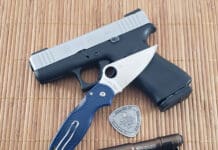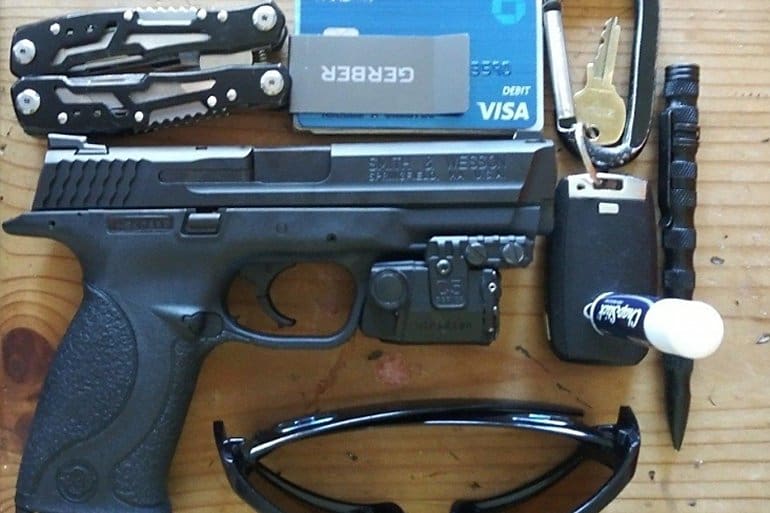As the Democrats are on stage at the CNN debate are busy telling us how we need to throw more US troops into Syria for like, forever, we bring you Eddie Chaps’ Everyday Carry from Florida.
Yes, it’s funny watching them twist themselves into pretzels. “We’ll restore America’s credibility,” they say.
Meanwhile Eddie’s got an M&P .45 ACP compact pistol. With a spare magazine.
He also carries a CAT tourniquet and Quik Clot. He’s also got a couple of lights, including an Olight S1 mini. Again, I got one because so many people carry them, but quickly found that it doesn’t have a momentary switch. Aside from that, it’s a pretty potent little light.
Throw in a Casio watch and a paracord bracelet. He’s also got a little keytool on his keyring (along with that little flashlight).
Back to the Democrat debate, with “dude gotta go” Ebonics from Kamala Harris.






I hope his holster is on his belt, which should be holding his pants up.
If you are actually watching the dim debacle you are either crazy or a masochist.
No offense.
Throw in a compact pressure dressing. TQ’s don’t work everywhere you can bleed to death from. Also, why do so many people not carry with a holster?
While you can bleed to death from a place that a TQ doesn’t work, there’s a reason to carry one as a first priority. In most civilized areas there is medical assistance available where people are going about their day (i.e. everyday carry). It’s a question of time and blood volume. So when you’re figuring out what medical stuff to have with you the question is: what can I carry that is likely to stop someone who would otherwise bleed out from dying before medical personnel can arrive?
If you sustain a limb injury there are enough blood vessels near the surface that it is easy to exsanguinate so quickly that it will happen before EMTs arrive. But a TQ can often be very effective in stopping that arterial bleed. A pressure dressing is not. Can it help with lesser bleeds? Sure. But most of those bleeds are not immediately life threatening. Those areas that are immediately life threatening but are not in the limbs are unlikely to be significantly improved by application of a pressure bandage. If you get shot in the heart or nearby vessels, for example, there’s very little that a bandage is going to do. If you get shot in the neck there’s a chance one might help but probably only if there’s minor vessel involvement.
Basically: if there’s blood loss rapid enough to be immediately life-threatening, a pressure bandage probably won’t help much while a TQ will if able to be applied. If the bleeding is not quite that bad a pressure bandage may help, but in most people’s daily lives it won’t be a determining factor.
I’m not saying it doesn’t make sense to carry one, especially if you are in areas where response times are long or if you anticipate EMS being unable to reach you in an emergency, but there are reasons why if you’re minimizing your gear, you’d drop the pressure bandage in favor of a TQ first.
So if a human gets shooted in the heart do I twist a rope around its head or stuff a Kotex in the hole? ,,,,( use rope, drag to ditch of hiway, let ripen, hope coyotes or cops dont find it.),,,
…and that is how possums do their barbaque. Keep it in mind should you ever receive an invitation.
S1 is probably the most popular non-gun EDC light. IMO, it’s a bad light to pair up with a handgun. With the button near the bezel, one has to feel for it to locate. I suppose like anything in life, practice until you’re proficient and some folks have fine motor skills under stress. If it doesn’t work out, time to go back to the tried and true tail cap switch.
If there’s paracord bracelet, a knife/multitool probably nearby…unless he cut the paracord with a bullet?
The best thing I like about this EDC is the key chsin multi tool.
Gun?check. Spare mag? check. Multitool?check. Tq and Qickclot? check, Flashlight? check, Holster and Mag Carrier? Nope.
I disagree with the earlier comment about leaving out a pressure dressing for torso wounds with hemorrhaging. Direct Pressure to the wound, whether Torso or Extremity, remains step A for field wound treatment is still the National Model EMS Guidelines and Trauma Nurse Core Curriculum for controlling bleeding. Direct pressure supercedes tourniquet application, as the end result of tourniquet use will often result in the loss of the limb distal to the tourniquet site, dependent upon the time between TQ application and transport to a facility for surgical intervention (between 1 to 2 hours in different studies). Studies of both Civilian and Military use of tourniquets both show a premature TQ application of 46-49%, where Direct Pressure of the wound would have sufficed.
Even though I retired and stopped renewal of my licences a couple of years back, as a former instructor, I’m still receiving updates to the guidelines yearly.
Comments are closed.